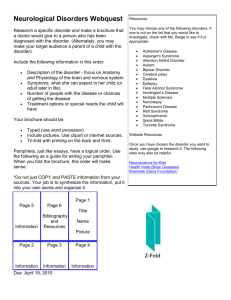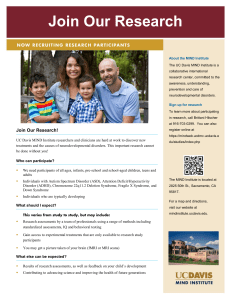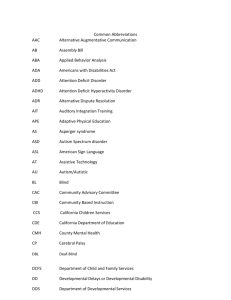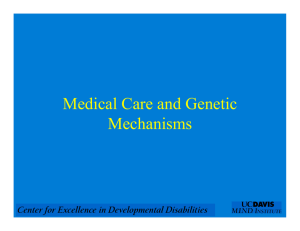Youth Mental Health and 22q11 Cameron S. Carter M.D.
advertisement
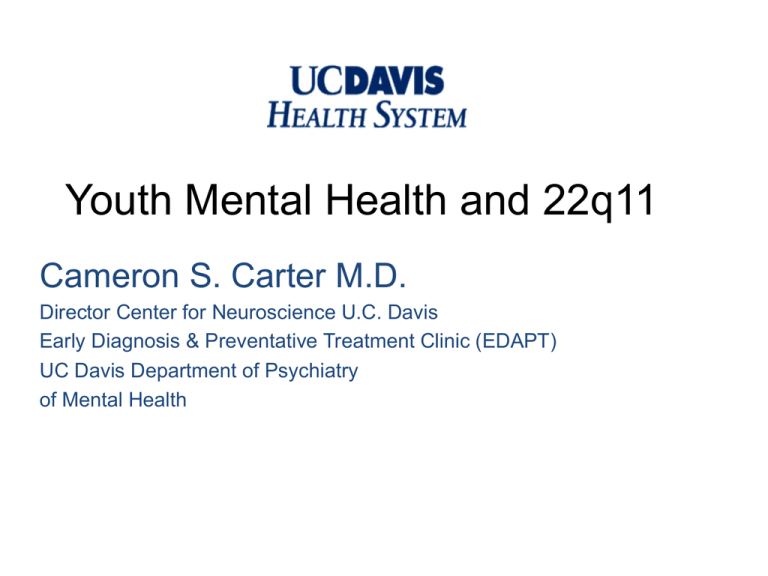
Youth Mental Health and 22q11 Cameron S. Carter M.D. Director Center for Neuroscience U.C. Davis Early Diagnosis & Preventative Treatment Clinic (EDAPT) UC Davis Department of Psychiatry of Mental Health Psychiatric Disorders are Common • Up to one third of all adults will have a life9me experience of mental disorder • Less that 30% will get treatment Psychiatric disorders are “developmental” • 80% will have earliest signs and symptoms before 18 years • Children with developmental disorders have increased rates of psychiatric symptoms • The symptoms are part of their developmental disorder and will respond to evidence based treatments rders were ose with the ention deficit, early half tic experiences. y and disrupted common.Poor associated with was more . etion syndrome nt adulthood. pected to orted psychotic s imply a tal disruption in associated with early adulthood. t None. For the same reason, we did not recruit participants for either group from clinical ser11 5 ^ 1 2 0 vices where referral was for behavioural or learning difficulties. Psychiatric disorder and behavioural problems were not exclusion criteria for comparison participants Adolescents and young adults with 22q11 because this would havedeletion biased the results METHOD towards a low rate of psychopathological Study participants disruption, of adolescents syndrome: psychopathology in an unrepresentative at-risk group and young adults with learning disabilities. This study received ethical approval from the KATE Great Ormond Street D. BAKER andHospital DAVID National H. SKUSE To counterbalance self-selection biases, literature about the study provided to Health Service Trust research ethics compotential cases and controls stated that it mittee. Written informed consent was tion syndrome is associated with specific developmental psychopathology similar to B R I T I S H J O U R N A L O F P S YC H I AT RY ( 2 0 0 5 ) , 1 8 6 , that seen in idiopathic schizophrenia, owing to shared genetic and pathophysiological mechanisms. Table 1 Study populations Microdeletions at chromosome 22q11.2 Background 22q11deletion syndrome Group t or w2 1 (22q11 deletion syndrome, velo-cardiois associated with high rates of psychiatric DiGeorge 22q11 deletion syndrome (n (nfacial ¼25) 25) syndrome, Controls (n (n¼25) 25)syndrome; premorbidity, especially schizophrenia. valence *1 in 4000) can cause heart and If common neurodevelopmental palate malformations, Gender (male : female) 15 : 10 17 : 8 mild to moderate 0.351 trajectories characterise 22q11deletion learning disability and communication1 imAge in years : mean (s.d.) 16.4 (2.0) 16.0 (2.9) 1.2 pairments (Scambler, 2000). Schizophrenia syndrome and idiopathic schizophrenia, Estimated IQ : mean (s.d.) 66 (15) 74 (16) 1.91 is a late manifestation in around 30% of then similar‘premorbid’features would cases, on a par with the risk to offspring 1. All P40.05. be predicted. Aims To define psychopathology in adolescents and young adults with 22q11 deletion syndrome. of two parents with schizophrenia (Murphy et al, al, 1999). People with schizophrenia have an 80-fold increased prevalence of the microdeletion relative to the general 11 5 population (Karayiorgou et al, al, 1995). Individuals with schizophrenia and a 22q11.2 obtained from participants age with 22q11 de cruited with t 22q11 Group (a and informatio informati disciplinary clin average genera learning disabi logical conditi major sensory be comparison these volunteer (64%), colleg (12%) and org services for you abilities (24%) current placem deletion syndro were recruited groups were w gender, age (ra and estimated I Given the s similar to previ dition), it is study volunteer scores. A symptom was counted as present for dimensional scoring if the participant met intensity criteria, regardless of whether frequency or duration criteria were met for T Table able 2 occur with neurocognitive dysfunctions (Nuechterlein et al, al, 2002). In this study, dimensional schizotypy ratings were derived from CAPA interviews according to control groups and the average symptom counts for each dimension investigated. Odds ratios for the risk of obtaining a diagnosis, given membership of the 22q11 DSM^IV diagnoses and dimensional symptom counts Disorder Number of diagnoses w2 22q11 deletion syndrome Controls ADHD, inattentive subtype 12 4 Anxiety disorder 10 2 Separation anxiety 0 0 Social anxiety 0 1 Overanxious 8 1 Phobia Mean dimensional symptom count (s.d.) Mann^ Whitney U 22q11 deletion syndrome Controls 6.8* 6.6 (3.1) 3.4 (3.2) 3.1** 6.7* 1.2 (2.0) 0.2 (0.9) 2.8* 11.1** 2.7 (2.4) 0.3 (0.9) 4.4** 2 0 Mood disorder 9 0 Dysthymia 4 0 Major depression 3 0 Hypomania 2 0 Manic episode 0 0 Obsessive^compulsive disorder 2 0 2.0 0.7 (1.5) 0.1 (0.4) 2.0* Conduct disorder 0 0 0 0.1 (0.4) 0.3 (0.6) 1.4 ADHD, attention-deficit/hyperactivity disorder. *P50.05; **P **P50.01. 11 6 From: High Rates of Schizophrenia in Adults With Velo-Cardio-Facial Syndrome Arch Gen Psychiatry. 1999;56(10):940-945. doi:10.1001/archpsyc.56.10.940 Date of download: 5/16/2014 Copyright © 2014 American Medical Association. All rights reserved. What is Psychosis? • A Brain Based Neurodevelopmental Disorder • Can be related to a serious mood disorder (depression, bipolar disorder) or a primary psycho9c disorder • Most Striking are the Posi9ve Symptoms -­‐ Hallucina9ons, Delusions, Thought Disorder • However, there are also Nega9ve Symptoms -­‐ Loss of interest, energy, pleasure, withdrawal • And Cogni9ve Impairments -­‐ problems in aRen9on, problem solving and memory • That Predict Func9onal Outcome -­‐ not responsive to current medica9on -­‐ poten9al for cogni9ve remedia9on How does Psychosis Develop? Positive symptoms Negative symptoms Risk for relapse At Risk phase Acute psychosis Recovery phase 1 week-1 year 1 week-1 month 6-36 months Biological Complexity • Multiple systems impacted at multiple levels! • Structural-Anatomical: cortical gray matter reduction, subcortical changes, sulcal & ventricular enlargement • Functional-Physiologic: reduced or irregular activation during various cognitive tasks • Cellular-Molecular: NT systems abnormalities à altered receptor distributions, increased cell density, decreased/aberrant connections between cells Early Intervention Rationale • Duration of untreated psychosis is associated with poor outcome • Early in illness treatment response is robust • Loss of function and treatment resistance follow repeated relapses • Early intervention can improve functional outcome • Tailored treatment pathways and therapies for early treatment and rehabilitation The EDAPT & SacEDAPT Programs % Patients Relapse-Free Duration of Untreated Psychosis and Rate of Relapse 90 80 70 60 50 40 30 20 10 0 Short DUP, N=31 (treatment <1 year after psychosis onset) Long DUP, N=22 (treatment >1 year after psychosis onset) 6 12 18 # Months after treatment entry 24 Adapted from Crow et al. (1986). Brit J. Psychiatry, 148, 120-127. Psychosis Prodrome • Period of early clinical signs that individual is at higher risk, but not always destined, for psychosis • Typically occurs during adolescence or early adulthood – between ages 15-25 (average age 17-18) • Average duration of 1-3 years • Likely association with brain maturation • Onset may be earlier for men than women Non-specific signs of prodromal psychosis A clustering of the following: • A significant deterioration in the ability to cope with life events and stressors – Decrease in work or school performance – Decreased concentration and motivation • Withdrawal from family and friends • Decrease in personal hygiene Specific signs of risk for psychosis Attenuated/subthreshold psychotic symptoms Marked changes in behavior, thoughts and emotions, such as: • Unusual perceptual experiences • Heightened perceptual sensitivity • Magical thinking • Unusual fears • Disorganized or digressive speech • Uncharacteristic, peculiar behavior • a “whiff” of psychosis… The EDAPT & SacEDAPT Programs Careful Assessment is Needed These symptoms CAN look similar to: • Depression or Anxiety • Substance Abuse • Reaction to abuse or trauma • Attention Deficit Hyperactivity Disorder • Reaction to family stress • Learning Disabilities • Pervasive Developmental Disorders PS Criteria of presence of a t a 3–5 severity report Global ed on the SIPS he Schedule for Aged Children, al., 1997) was morbid mental assess autistic mental disorder al Manual, 4th ychiatric Asso- • eted live clinical ew tailored to eligible psychiording to their view. JS and RH nterview, and es. Interviewer (for JS and TN) (Miller, et al., occurring at least once per week. Notably, no other positive symptom score was above the Research “questionably present” level for Schizophrenia 118 (2010) 118–121 these two individuals, their total positive symptom scores were Contents lists available at ScienceDirect 4 and 5. In contrast, six of the remaining seven 22q11.2DS SchizophreniaAPS Research individuals reported long-standing symptoms and therefore did not meet syndrome. j o u r n acriteria l h o m e p a g e :for w w w.a e l s CHR ev i e r. c o m / l o c a t e / s c h r e s These six included those with the highest positive symptom total scores, Brief 13,report 13, and 14. SOPS positive total scores across the fourin domains Attenuated symptoms of psychosis adolescentswere with not chromosome deletion syndrome associated 22q11.2 with age or intelligence. SES was inversely Joel Stoddard a,⁎, Tara Niendam b, Robert Hendren c, Cameron Carter b, Tony J. Simon a a Department of Psychiatry and Behavioral Sciences and the Medical Investigation of Neurodevelopmental Disorders (M.I.N.D.) Institute, University of California at Davis Health System (UCDHS), United States b Department of Psychiatry and Behavioral Sciences and the Imaging Research Center, UCDHS, United States c Department of Psychiatry, University of California at San Francisco, United States Table 1 Participant characteristics. a r t i c l e i n f o Age (years) Median (IQR), range Female Keywords: SES Chromosome 22q11.2 deletion syndrome Mean (SD) VCFS Schizophrenia FSIQ Prodromal psychosis Clinical-high-risk psychosis Mean (SD) GAF Mean (SD) Article history: Received 22 August 2009 Received in revised form 10 December 2009 Accepted 14 December 2009 Available online 6 January 2010 a b s t r a c t 22q11.2DS n = 20 15.1 (4.3), 12–22 Thirty percent of individuals with chromosome 22q11.2 deletion syndrome (22q11.2DS) develop a psychotic disorder, particularly schizophrenia. We assessed attenuated positive, negative and disorganized symptoms of psychosis and clinical-high-risk syndromes in 20 adolescents with 22q11.2DS (median age 15.1 years) using the Structured Interview for Prodromal Symptoms (SIPS). Two participants met criteria for the Attenuated Positive Symptom Syndrome, while nine participants (45%) experienced positive symptoms rated in the “moderate” to “severe and psychotic” range on the SIPS. Almost all presented with moderate to severe symptoms in the negative, disorganized, and general symptom domains. © 2009 Elsevier B.V. All rights reserved. 1. Introduction Mental disorders are common in chromosome 22q11.2 deletion syndrome (22q11.2DS), which is caused by a microdeletion at chromosomal region 22q11.2 (OMIM accession nos. 188400, 192430, and 145410). Psychotic disorders, especially schizophrenia, have a lifetime prevalence of about 30% (Murphy and Owen, 2001), which is disproportionately high with respect to other neurodevelopmental disorders 70% 48.9 (14.0) 76.2 (10.9) 58.8 (10.8) youth with 22q11.2DS (Baker and Skuse, 2005; Debbane, et al., 2006; Feinstein, et al., 2002; Vorstman, et al., 2006). However, examining subclinical psychotic-like symptoms may yield additional information about the presentation of psychosis in this at-risk population. Consequently, Baker and Skuse (2005) studied schizotypal personality disorder symptoms in adolescents with 22q11.2DS. While 48% (n = 12/25) reported transient psychotic-like symptoms, 84% (n = 21/25) endorsed at least one schizotypal symptom. Table 2 KSADS-PL determined mental disorders. a Table 3 Presentation of SIPS 22q11.2DS n = 20 Diagnosis Current n (%) Lifetime n (%) Any disorder PDD NOS ADHD ODD Tourette's disorder Enuresis Alcohol dependence Any anxiety SAD GAD OCD Panic disorder PTSD ASD Social phobia Specific phobia Anxiety disorder NOS Any mood MDD Depressive disorder NOS Adj. disorder with depressed mood 15 (75) 5 (25) 6 (30) 1 (5) 1 (5) 2 (10) 1 (5) 11 (55) 1 (5) 4 (20) 1 (5) 0 (0) 1 (5) 1 (5) 2 (10) 6 (30) 2 (10) 3 (15) 2 (10) 1 (5) 0 (0) 18 (90) 5 (25) 7 (35) 1 (5) 1 (5) 6 (30) 1 (5) 12 (60) 4 (20) 4 (20) 4 (5) 1 (5) 1 (5) 2 (5) 5 (25) 7 (35) 2 (10) 5 (25) 4 (20) 1 (5) 1 (5) a Data are presented as the number of adolescents who met criteria for a diagnosis. Current refers to disorder present or partially remitted within 2 months prior to assessment. Lifetime refers to any history of the disorder. Abbreviations refer to the following disorders: NOS = not otherwise Positive symptom Unusual thought Persecutory delus Grandiosity Perceptual abnorm Disorganized com Negative symptom Social anhedonia Avolition Expressions of em Experience of em Ideational richnes Occupational func Disorganized sym Odd behavior or a Bizarre thinking Problems with at Impairment in hy General symptom Sleep disturbance Dysphoric mood Motor disturbanc Impaired toleranc stress Stoddard et al 2010 • 2 (10%) met aRenuated posi9ve syndrome criteria • 8 more had some evidence of aRenuated symptoms but we do not know the significance of this What are effec*ve treatments? • Biological Factors – Medication – Substance use management • Cognitive/Psychological Factors – Cognitive Therapy – Cognitive Remediation – Skills Training – Supported Education/Employment – Peer/Family Support • Environmental/Family Factors – Family Therapy Entry Criteria for EDAPT Clinic • • Ages 12-25, IQ> 70 , no medical illness/injury affecting cognition Drug use Ok, but no dependence • Recent onset of psychosis (within the past year) includes affective and non-affective psychosis or Attenuated positive symptoms or Recent deterioration in youth with a parent/sibling with a psychotic disorder • • • Also serve Mood/Bipolar Disorder (with attenuated or psychotic features) EDAPT Offers: • Phone consultation – Support for professionals like you! • Comprehensive Psychiatric Assessment • Case Management – Psychoeducation – Crisis management & Problem Solving • Groups: • • • • – – – – Multifamily Group Family Support Group SAMM Peer Support Group Support from Peer & Family Advocate Supported Education/Employment Medication Management Monitoring and support for 2 years The EDAPT & SacEDAPT Programs Contact Information EDAPT & SacEDAPT Phone Consultation Hours: 9:00am – 5:00pm M-F EDAPT referrals: Jane Dube – 916-734-2964 SacEDAPT Referrals: Markie – 916-734-7251 http://earlypsychosis.ucdavis.edu



